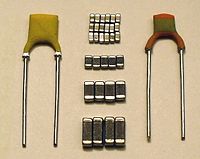
Photo from wikipedia
Natural image statistics exhibit temporal regularities of slow changes and short-term correlations and visual perception, too, is biased toward recently seen stimuli, i.e., a positive serial dependence. Some studies report… Click to show full abstract
Natural image statistics exhibit temporal regularities of slow changes and short-term correlations and visual perception, too, is biased toward recently seen stimuli, i.e., a positive serial dependence. Some studies report strong individual differences in serial dependence in perceptual decision-making: some observers show positive serial effects, others repulsive effects, and some show no bias. To understand these contrasting results, this study separates the influences of physical stimuli per se, perceptual choices, and motor responses on serial dependence in perceptual decision making. In two experiments, human observers reported which orientation (45° or −45°, at threshold contrast) they perceived. Experiment 1, used a consistent mapping between stimulus and response buttons whereas in Experiment 2, observers did two tasks: one with a consistent stimulus-response mapping, the other with a random stimulus-response mapping (perceptual choice and motor response unrelated). Results show that the stimulus percept (not the physical stimulus per se) affected subsequent perceptual choices in an attractive way and that motor responses produced a repulsive serial effect. When the choice-response mapping was consistent (inseparable choice and response, typical of most experiments), individual differences in the overall serial effect was observed: some were positive, some repulsive, and some were bias-free. The multiple regression analysis revealed that observers’ overall serial effects in the consistent choice-response mapping task could be predicted by their serial effects for choices and motor responses in the random mapping task. These individual differences likely reflect relative weightings of a positive choice bias and a repulsive motor bias.
Journal Title: Journal of Vision
Year Published: 2020
Link to full text (if available)
Share on Social Media: Sign Up to like & get
recommendations!